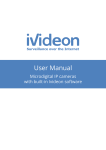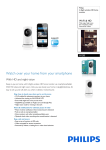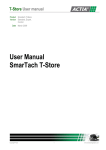Download User Manual - Your Push Zone has been created.
Transcript
Cloud Video Surveillance User Manual Microdigital IP-cameras with built-in Ivideon software Table of Contents Ivideon: basic concepts What is Ivideon? 3 3 What is an IP camera with built-in Ivideon software? 3 How to access your surveillance cameras? 3 Attaching an IP camera to your Ivideon account 4 Camera settings 4 Camera Web Interface 4 Network settings 5 Wi-Fi settings 6 Motion detector settings 7 Sound recording settings 8 Video stream settings 9 Upload bandwidth configuration 10 Frame rate settings 11 Resolution settings 11 Elimination of the "traveling wave" effect 12 Setting up access to the Internet via proxy-server 12 Date and time settings 13 Recording video archive on a micro SD card 14 3 Ivideon: basic concepts What is Ivideon? Ivideon is a system that allows you to easily organize video surveillance at any place: office, apartment, house, shop, enterprise. Ivideon features: • • You only need a computer and web- or IP-camera to set your own video surveillance system; The installation process is extremely simple: connect your surveillance cameras to a computer, configure the Internet connection and attach the cameras to your Ivideon account. What is an IP camera with built-in Ivideon software? An IP camera with built-in Ivideon software works with Ivideon cloud by itself — there is no need to connect it to a computer. It is an independent element of your video surveillance system, you can just attach it to your Ivideon account — and you will be able to access it from anywhere over the Internet. How to access your surveillance cameras? If you attach your camera to your Ivideon account, you will be able to access it from any place and any way you like: via your personal account on the Ivideon website; on Android devices via Ivideon for Android; on your iPhone®, iPad® or iPod® via Ivideon mobile application for iOS; on other mobile devices via the mobile version of the Ivideon website; on your computer via desktop version of the Ivideon Client application. 4 Attaching an IP camera to your Ivideon account To use your camera with built-in Ivideon, attach it to your personal account on the Ivideon website - www.ivideon.com. If you do not have an Ivideon account yet, please visit www.ivideon.com and sign up. 1 Prepare the camera for connection. Connect it to your router with an Ethernet cable. Get ready to plug the power cable into the camera. 2 Log into your account at www.ivideon.com. Go to My cameras tab and click Add a camera or a DVR. Follow the instructions. Attention! If you need to reattach your camera, follow the instructions above, but first delete the camera from your personal account. Camera Settings Camera Web Interface Microdigital IP-cameras can be configured via their web-interface. To access it, type the IP-address of the camera in your browser. If you don't know the IP-address of your camera, you can see it in the Microdigital IP installer application (can be found on the Microdigital CD supplied with the camera. Also, the application is available for downloading on the Microdigital website). Click Admin in the top menu. Default settings for accessing the camera: login - root, password - root. The camera web-interface will be displayed correctly only in Internet Explorer 8 or higher with the Active X MDiViewer plugin installed (will be prompted to install automatically). 5 Network settings Network settings can be configured via the Microdigital IP-installer application. Attention! MICRODIGITAL IP Installer works only on Windows. On other operations systems, the Wi Fi settings can be configured only via the camera Web Interface. 1 Connect your camera to a computer or a router with an Ethernet cable. 2 Install and open the MICRODIGITAL IP Installer application. 3 Press the Search product icon. Wait until the searching process is finished, the camera should appear in the list. During the searching process we recommend disabling all the blocking programs (antiviruses, firewalls, etc.). 4 Wait until the searching process is finished, the camera should appear in the list. Right-click on your camera and select Setup product IP. 5 6 Select the type of network connection: DHCP if your network is running a DHCP server (automatically receive network settings from router). If you don't have a DHCP server on your network, select Static and configure the network settings for your camera manually. If you camera doesn't support WiFi connection, skip to Step 9. Click the Scan AP button and select the Wi-Fi network you want to connect your camera to. 7 In the Auth Mode line select the encryption method used on your Wi-Fi network. You can check the Wi-Fi encryption settings on any device that is already connected to your Wi-Fi network. 8 Type your Wi-Fi password in the WPAPSK line. 6 9 Type the password for your camera in the Admin Password line (By default - root) and press Set. 10 Wait until the searching is finished. Unplug the camera power supply, disconnect the Ethernet cable and turn on the power. 11 Wait for 3-5 minutes and press the Search product icon again. Wait until the searching is finished, the camera should appear in the list. Attention! The network settings must allow the camera to gain access to the Internet network. For the correct operation of the device, we recommend setting up the following DNS settings: DNS1 - 8.8.8.8, DNS2 - 8.8.4.4. Wi-Fi settings 1 Open the camera web interface. In the side menu select «Network Configuration» «Network Configuration». 2 Select DHCP Client as the type of network connection if you have a DHCP server running on your network. Otherwise select Static IP. 3 Click the Scan AP button and select the Wi-Fi network you want to connect your camera to. 4 In the Auth Mode line select the encryption method used on your Wi-Fi network. You can check the Wi-Fi encryption settings on any device that is already connected to your Wi-Fi network. 5 Type root in the KEY field. 7 Motion Detector Ivideon starts the archive recording only when the motion detector is triggered. If the motion detector is disabled, the video feed will not be stored on an SD-card nor in the cloud. To configure motion detection on your camera, perform the following steps: 1 Open the camera web interface. In the side menu click Device Configuration Camera & Motion Motion Detection. 2 Select Enable. 3 Set the detection area. Active segments are displayed in green, inactive are shown in red. Click on a segment to activate / deactivate it. Click Check All or Uncheck All to activate or deactivate all segments. 4 Adjust the motion detector sensitivity — Motion Sensitivity. Optimal values are 0 - 10. Click the Apply button. 8 Sound recording settings If your camera is equipped with a microphone, you may need to enable and configure sound, which will be broadcasted along with the video feed and recorded on an SD-card. 1 Open the camera web interface. In the side menu click Device Configuration Camera & Motion. 2 In the opened window, set the Audio flag to Enable and press Apply. 9 Video stream settings By default the camera is configured in optimal settings. If the upload bandwidth is low (for example, if you're using a 3G-modem), it's possible to configure the video stream settings in accordance with your requirements. t The camera has 2 video channels and you can set different values for each channel. • Primary Stream — video from this channel is used for recording and watching live video in high quality. • Secondary Stream — video from this channel is used when you watch live video in middle and low quality. 10 Upload bandwidth configuration 1 Open the camera web interface. In the side menu click Device Configuration Camera & Motion Primary Stream. 2 On the Camera Configuration (Primary Stream) setup panel, select CBR mode for the parameter Rate Control Mode and set the required upload bandwidth in the Bit Rate Control line. Click Apply. 3 Similarly, set settings for the second channel of the camera (Secondary stream). Attention! For the proper operation of the device, the Bit Rate Control parameter must be less than or equal to your Internet upload bandwidth. 11 Frame rate settings 1 Open the camera web interface. In the side menu click «Device Configuration» «Camera & Motion». 2 On the Camera & Motion configuration panel set the required frame rate per second (fps). Click Apply. Similarly, set settings for the second channel of the camera (Secondary stream). Resolution settings 1 Open the camera web interface. In the side menu click «Device Configuration» «Camera & Motion». 2 On the Camera & Motion configuration panel set the required resolution for the Image Size parameter. Click Apply. Similarly, set settings for the second channel of the camera (Secondary stream). 12 Elimination of the "traveling wave" effect If you use your camera indoors, you may notice a “wave” effect on the picture. To eliminate this effect, open the camera web-interface. In the side menu click Device Configuration Camera & Motion Camera Control. In the opened window, switch the Power Frequency flag to 50Hz and press Apply. Attention! After any change in the video settings, the Ivideon service must be restarted. To stop the service, open the camera web interface. In the side menu, select Ivideоn and click the Stop Ivideon Service button. Wait until the page refreshes and click the Start Ivideon Service button. Setting up access to the Internet via proxy-server If you use a proxy server to access the Internet, select Ivideon in the side menu and enter the proxy URL in the Configure HTTP Proxy section. Otherwise, leave this field empty. 13 Date and time settings on the camera For proper recording of the archive, set correct date and time settings: 1 Open the camera web interface. 2 In the side menu, select «System Configuration» «Date & Time». 3 On the Local Date & Time Configuration panel, check the Change Time Zone box and indicate your Time Zone. Click Apply and then Reboot. 4 Wait until the camera reboots and go to the panel Local Date & Time Configuration . Press the Get NTP server time button. If the time settings haven't been set, you should adjust it manually. 14 Recording video archive on a microSD card To store video archive on an SD card, you will need 1 - 32 GB microSD and speed class 6 or higher. To configure archive recording, perform the following steps: 1 Open the camera web interface. In the side menu click Ivideon and press the Stop Ivideon Service button. 2 Insert the microSD card into the camera. 3 In the side menu click «Recording Configuration» «SD Configuration» «SD Status & Format». 4 Select 1st SD and press Partition and Format. Wait until the formatting is finished. Press the Reboot button. 5 In the side menu click Ivideon and in the Configure Video Archive section enable the Enable Video Archive flag. 6 Press Start Ivideon Service. Attention! If you need to remove the SD-card from your camera, you need to stop the Ivideon Service first (see step 1 above). Unplug the power supply and remove the card.




























